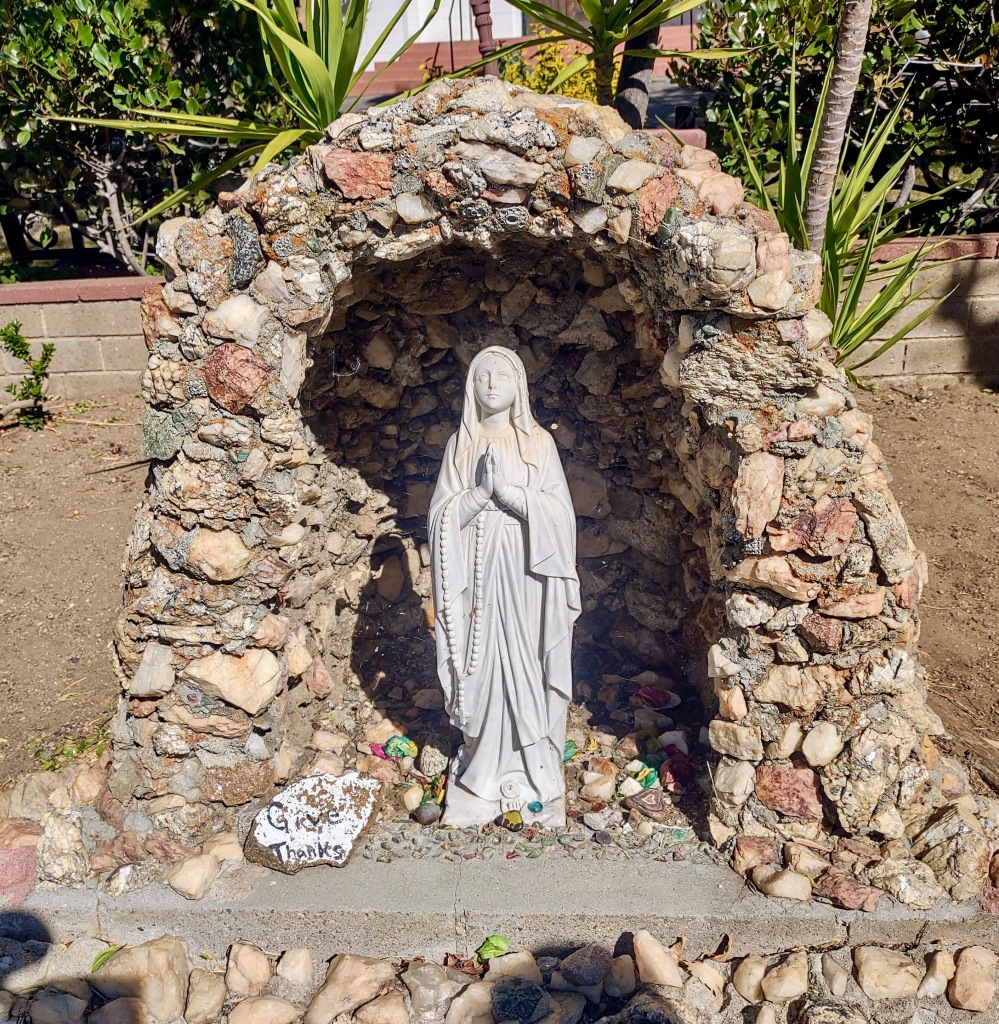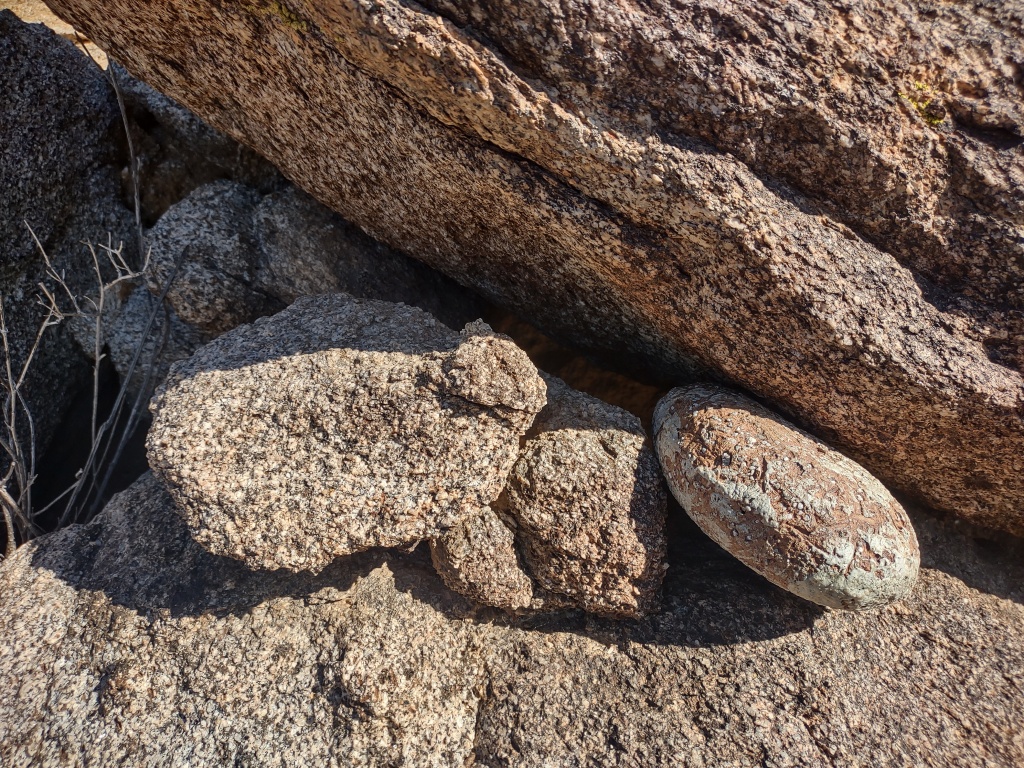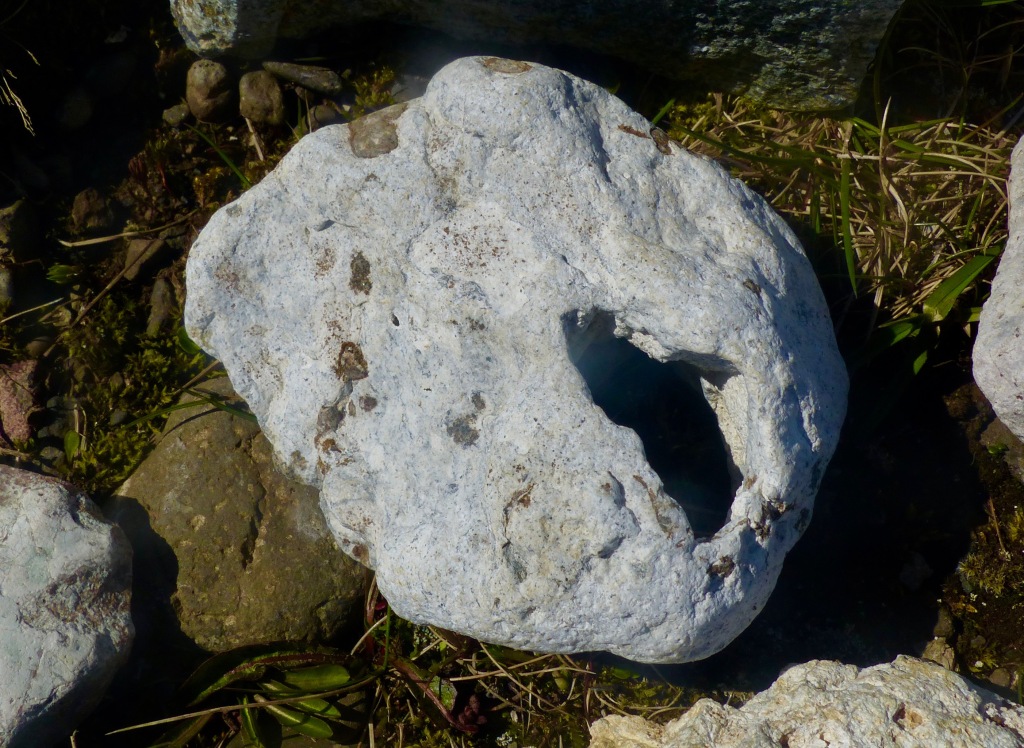For over a decade, Pierre Jardin has enjoyed tanseki (rock-collecting) excursions with fellow members of California Aiseki Kai, a suiseki and viewing stone group that meets monthly and has an annual viewing stone show at the Huntington Library and Gardens. Tanseki is a slow time practice; it entails an attentive walk in a landscape, scanning the ground for distinctive rocks. You pause when something piques your attention; you might kick it loose or turn it over with a stick (or “treasure scoop”); you might pick it up and examine its patina, turn it different ways to find the most pleasing view of it, hold it on your palm to simulate what it would look like mounted as a viewing stone. Tanseki demands a particular focus both brain and eyes—you try to train your gaze on material pebble-size or smaller, because “you’ll always see the bigger stones,” as veteran rock-hunter Marty advises. Tanseki is a wonderful way to forge an intimate relationship to a particular place, and by extension, the planet. It cultivates an immersive, multi-dimensional, sometimes nearly synesthetic form of attention; as you scrutinize the stones, you receive and listen to the landscape; you contemplate rocks as traces of events (earthquakes) and forces (wind, rain) and processes (erosion). In pursuing this practice, you are probably recuperating an interlock with the world already deeply embedded in our DNA, but rusty with disuse. Scanning for stones is surely an archaic activity of the genus homo—looking for useful tools (handaxes, arrow heads) dates at least to the Neolithic, and seeking out symbolically expressive rocks (e.g., figure stones) dates back to species older than homo sapiens. So, as the Aiseki Kai caravan of cars stops in the desert and people fan out to search for stones, Pierre Jardin sometimes imagines bands of ancient peoples doing something surprisingly similar.
On the group’s autumn tanseki to the Yuha Desert, Pierre Jardin was joined by Lowell Nickel, his ceramics sensei—Jardin recently joined Lowell’s ceramics class at Angels Gate Cultural Center. Lowell makes ceramic “Faux Stones” that he uses in multiple ways, including assembling them to form an “Asteroid Belt,” as seen in this recent exhibition at Angels Gate.

Since 1999, Lowell has been siting Faux Stones in the East Mojave Desert. “My hope,” he says, “is that these hollow stoneware and porcelain objects will, over time, mature into a geode or solid nodule.” For the trip, Lowell packed up several ceramic stones. At each stop on our drive through the Anza Borrego desert and during the two days in the Yuha, we would put a few in our packs and seek suitable spots to site them. This doubled our fun, as we had a dual purpose: to pick up interesting rocks and plop down ceramic stones. (When I phrased things this way, Lowell deemed it the birth of Plop Art.)
Pierre Jardin was honored that Lowell invited him to join in his longstanding Faux Stones project. It also transformed the Tanseki in an interesting way: simply taking stones from the landscape turned into a form of trade, an exchange of Faux Stones for real rocks. Throughout the weekend, as he relished the novelty and pleasure of this experience, Jardin found himself pondering several questions: how does placing ceramics in the landscape in tandem with picking up stones change our relationship to the landscape? How does it impact our relation to the Earth? Jardin found himself conducting a kind of thought experiment; while walking in the desert, exchanging Faux Stones for rocks, he explored a zone of conceptual exchange between ceramics and geology. What are the relations between ceramics and geology? How does thinking them together in this context help us consider the interaction of ceramics and stone?
Journey
On our way to Anza Borrego, we stopped at the Santa Isabel mission and enjoyed an idyllic picnic in the breezy shade of cypress trees. Pierre Jardin was deeply affected by this beautiful shrine of the Virgin Mary in a stone grotto, sited on a mosaic wall of striking quartz and conglomerate rocks.

The painstakingly constructed grotto incorporates myriad lichen-laced pebbles and small tokens. The rock matrix both envelopes Mary in a protective womb and provides a dark, rugged backdrop that accentuates the purity of the white marble statue.
The shrine situates Our Lady of Grace in her geologic niche, one might say: religious devotion merges with a deep connection to the local landscape discernible in the care dedicated to selecting aesthetically appealing stones, recasting the Virgin Mary as an Earth Mother. Seeing the many painted rocks left in tribute to her prompted Lowell to site a Faux Stone behind the statue, where it blended in seamlessly, with its green glazed globular pieces adding a visual echo of a green glass rondel left at Mary’s feet.


In retrospect, the unexpected impact the shrine and Mission had on us marked the beginning of a pilgrimage into the desert—not a religious pilgrimage, of course, but an art pilgrimage. Architect and land artist Charles Jencks, in his book The Universe in the Landscape, observes that: “Touring from one destination to the next has created that contemporary character known as the ‘art pilgrim,’ a character not unlike explorers of 5000 years ago who walked and sailed, stopping at ritual landscapes such as Stonehenge, orientated to the salient cosmic points and landscape features” (p. 119). While the art pilgrim has particular places in mind though, Lowell and Pierre were more like watchful wanderers, looking for locations to leave an inconspicuous artistic footprint.
Our first exploratory stop in Anza Borrego Desert State Park was Blair Valley, where a dirt road dotted with primitive campsites winds along the foot of a rocky ridgeline. These rocks are part of the La Posta Pluton, a 94 million year old batholith of two granitoids, tonalite and granodiorite. Lowell stopped at a secluded spot and handed me a few Faux Stones, offering only loose instructions to put them “somewhere where it makes sense in the landscape” and expressing a hope that they would likely remain unfound by people for a long time. Clambering around this terrain is difficult—the hillside is steep and sandy, and the rocks pitch unevenly and are rough on hands and feet. But slowing down and looking for interesting spots to site stones attunes you to the contours and cracks in the rocks, and makes you realize that the ridge is a rock-fractal, a fractured rock formation composed of broken pieces that are each rocks composed of broken pieces, at every scale.
Pierre Jardin started his stone-siting with an easy one: a piece of Lowell’s whose color and texture were a close match for the existing rocks. He found a crevasse that both hid and held the stone in place, while the crevasse itself served as a beautiful sort of lensing device to see the sky through, a bit like a James Turrell Skyspace. The Faux Stone became a kind of ceramic chameleon, creating such a seamless match with the natural rock that it seemed like a form of mimicry, a material iteration or literalization of art as mimesis.
A similar merging of ceramic into stone context occurred when colorful balls on a ceramic piece placed in a marvelous play of shadows blended with juniper berries on a lichen-covered granite boulder.
Finding the perfect fit produces a playful feeling of pleasure, as well as the pleasure of hiding something in a place where it is unlikely to be found. This joy is tinged with a melancholic ambivalence, realizing that the perfect secret hiding place cannot be shared without being lost, like a hiding place in hide-and-go-seek where you are never found. At the same time, this solitary predicament was offset by a feeling of complicit solidarity in the knowledge that Lowell was doing the same thing.
The next niche suitable for siting a stone was in a crack along a tilting diagonal kind of axis, where it nestled in snugly and fit proportionally alongside the other rocks. This placement is particularly pleasing because it is visible from the campsite below—provided you know what you are looking for.



It adds the perverse pleasure of fooling others—not hiding something obscurely but hiding it in plain sight, a trope at the heart of Pierre Jardin’s favorite detective story, Edgar Allan Poe’s “The Purloined Letter.” For a moment, Jardin felt like Poe’s Dupin, able to be duping others while seeing what others don’t see.
Driving south on S2, a beautiful switchback climb from Carrizo Canyon through the Sweeney Pass leads to the Carrizo Badlands Overlook. Over the last several million years, the basin has undergone major faulting, folding, uplift, and widespread erosion and rotation, and contains fossil remains of camel, sloth, mastodon, and horse ancestors. As we admired the view, a nearby ocotillo caught my eye; up close, its roots, stalks, and thorns look almost petrified, and, surprisingly, rocks are lodged tightly in them. A gap between rocks was an irresistible spot to nestle a Faux Stone, adding a ceramic wrinkle to the existing entanglement of geologic and organic components.
It was when we joined our Aiseki Kai friends for the Yuha tanseki that Pierre Jardin felt the full difference it makes to enter a place with the double purpose of leaving ceramic stones and looking for interesting rocks. The sand environment changed from serving as an essentially passive background to rocks to an active element to interact with; simultaneously, his gaze shifted levels of focus from one- to three-inch pebble-sized materials to six- to eight-inch Faux Stones. Finally, he noted the direct contrast in the two activities: scanning for interesting rocks depends on differentiation–you look for exceptions, what stands out, irregularities or anomalies; whereas watching for places to leave a ceramic stone depends on sameness—you look to merge the pieces with the rocks and other elements on the ground. Playing these two games simultaneously—or rather toggling between them—deepened Jardin’s engagement with the earth. It intensified his visual attention to color, size, patterns, and form in the materials and awareness of the changing contours in the land. He also became more attuned to the distribution and groupings of rocks and materials.

When he came across a group of similar pieces that he identified as petrified wood, he realized that they must have come from an eroded log or two. On previous trips, he did not prioritize this kind of noticing of materials or engage in speculative reconstructions of their histories.
Jardin noticed as well that placing manufactured artifacts in the landscape made him much more cognizant of other traces of human production and inclined him to photograph the Faux Stones with found objects. Contemplating coiled bunches of hanger wire led to associations with crop circles, suggesting a landing space for a ceramic piece; nested together, these alien elements in the landscape coalesced as kind of enigmatic assemblage.

It gave Jardin a glimpse into a practice and aesthetic Noah Purifoy developed on a grand scale and with great nuance in assembling his massive Outdoor Desert Museum in Joshua Tree.
The Faux Stones also deepened appreciation for particular places and materials in the variegated geologic wonderland of the Yuha. At one stop, Pierre Jardin spent the whole time on a small hillside whose crust was composed of sandstone ventifacts with fascinating forms of varying size. There was an immediate, suggestive similarity between the cracked surfaces of sand-, wind- and water-sculpted sandstones and the corrugated texture of the fired clay ceramics, which Jardin documented by posing a creased Faux Stone atop a crackled sandstone boulder.

The resemblances in color and texture serve as a reminder that ceramic harnessing of fire and clay mimics geologic processes. At one point, Lowell humorously observed that the Yuha rocks “are like mine, but better,” and stipulated that ceramics cannot replicate two elements in geology: pressure and time. Thinking about different natural forces and techniques humans use to harness different energies, Jardin sited a ceramic amid wind-shaped ventifacts where white windmills rise up in the distant background.

In this context, it is fitting to recall that Lowell frames his work in terms of the Anthropocene. Just as ceramics serves as a compressed version of geologic processes, Lowell projectively imagines his Faux Stones persisting in geologic space and timescales: “Over time, when the weathering forces of nature serve as the ultimate liberator of all human creations, these remains might resemble just another strange abstracted strata upon a future landscape…” As Lowell drily states, “guess that makes me a landscape artist.”
Play is fundamental to Lowell’s Faux Stones project. He is playing with himself as an artist, assuming geologic, mythic, and cosmic dimensions. He is playing with nature, experimenting with materials and processes and opening a whimsical dialogue with the environment. And of course he is playing with people, leaving cryptic traces in the world that, should someone stumble on them, will mess with their mind.
The Faux Stones are interesting to consider as a reflection of the ability of ceramics to replicate geologic processes or the potter as a compressor of Earth energies. In ethological terms, the Faux Stones can be understood as a form of mimicry (imitation as it happens in nature, as with chameleons); in aesthetic terms, they exemplify a form of mimesis (art as imitation of nature). Shifting registers, what if we consider them in linguistic terms? Like ceramics, writing originated as a way of working with clay. Gabriel Reed, in his doctoral thesis Being and Clay, draws comparisons between the scribe and potter, and the practices of cuneiform and wedging. Reed posits that “In its essence, the art of the potter is the act of listening to the language of clay and writing its poem with muddy words.” Seen as words, Lowell’s Faux Stones play like puns on the rocks they resemble. This understanding of course grants primacy to natural rocks–the ceramic pieces are puns “on” the existing material in the world.
We might give a final turn to this though. Literary scholar Sigurd Burckhardt, in his essay “The Poet as Fool and Priest” (1956), flips the script on puns, seeing them as showing how “many meanings can have one word.” From this standpoint, a pun becomes an intersection of multiple meanings, rather than a double or echo of a primary word-meaning. If we apply this logic to the Faux Stones, they no longer function as a secondary riff or play on a primary word or thing. Instead, ceramic pieces and rocks are equal instances or versions of a single ‘thing’ or sign–in this case, a process of material formation and transformation. Rather than a dichotomy between nature and culture, where art transforms raw nature into an aesthetic object, ceramics here is seen as an extension of geology (the rock cycle). Such a view is famously upheld in the non-dualist work of potter and poet M.C. Richards. In The Crossing Point, Richards distills this view succinctly: “To work with clay is to be one with the phenomenon of the earth… It is to take earth so sensitively that one can shape it into form.”
In this vein, Pierre Jardin concludes that real rocks and Faux Stones epitomize equally the beauty and power of earth being shaped into form. And so it turns out that exchanging ceramics for rocks–siting Faux Stones and collecting cool rocks–opened a conceptual zone of exchange in which ceramics became interchangeable–or at least exchangeable–with earth processes.



























































































